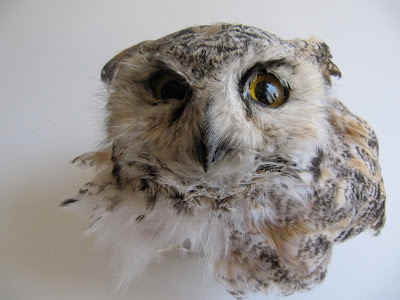 The Red-Tailed Hawk in the photo above is about to die. A co-worker brought it to our job site dazed and immobile. We guessed that it had been struck by a passing vehicle, sent wheeling to the edge of the road. Its breath was shallow and its eyes were fixed.
The Red-Tailed Hawk in the photo above is about to die. A co-worker brought it to our job site dazed and immobile. We guessed that it had been struck by a passing vehicle, sent wheeling to the edge of the road. Its breath was shallow and its eyes were fixed.So a debate ensued about our relationship to this beautiful creature. Was it our duty to attempt a rescue? Would killing it be a mercy? And, incongruously; is it efficacious and proper to attempt a divine intercession on its behalf?
A young woman that I work with was in favour of calling Fish and Wildlife for rescue and calling on God while we waited. Another co-worker thought we should twist its head from its neck, to speed up a foregone conclusion. I wasn't sure what to do.
When I was young I encountered a sparrow on the side of the road. I only noticed the bird because it didn't fly away as I approached. So I crept closer, being careful, interested in seeing how close I could get before it flew away. But it didn't fly away. It just stood there blinking in the gravel and short grass at the edge of the road. I bent down, certain that it would take flight. I'd never been so close to a bird before and it felt strange and thrilling. My heart was beating fast and loud as I put my hand near it, moving so slow. Eventually I picked it up in my palm. I remember thinking about how odd its feet felt on my hand. It cocked its head. Hopped.
And then it was gone. I was so shocked at its flight that I nearly fell over.
So I thought about that experience as I held that hawk in my hands. Could it be stunned? Will it suddenly writhe from my hands and fly away?
Meanwhile we talked about our options. A prayer was being muttered. And the hawk died.
The three of us all agreed that it was a beautiful animal. And I think we all felt that we had been offered a rare experience that morning. But the girl and I disagreed about the import of it. I wondered aloud what made that hawk special, that God would let it live if asked. It was arrogant, I said, to think that our gaze should somehow confer on that hawk an exemption, that once we notice something it becomes more important than the unseen life all around us. I struggled with the proper words to explain what I thought was important about holding that hawk while it died. Something about awe, about fragility; the idea that the experience was a gift, whether you believe that it was a present from God or not.
I can't help thinking that this girl missed an opportunity to be thoughtful, to see and feel something strange and special. A chance to have something brought to eye-level that we normally only see as a speck in the sky. She missed it by making it about herself, casting herself as arbiter and hero, presuming to speak to God on that hawk's behalf. She missed it by thinking that a dying hawk is a problem to be solved. She missed it by believing that she had something to offer that hawk, never thinking that it was the other way around.















